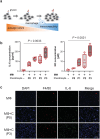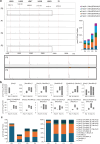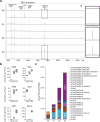Associations between glycan signature alterations and the cellular antigenic properties of passaged chondrocytes
- PMID: 39654889
- PMCID: PMC11625746
- DOI: 10.3389/fimmu.2024.1475473
Associations between glycan signature alterations and the cellular antigenic properties of passaged chondrocytes
Abstract
Background: Cartilage repair is a significant clinical challenge because of the limited intrinsic healing capacity. Current therapeutic strategies, such as cell transplantation therapy, aim to overcome this challenge by replacing damaged tissue with healthy cells. However, the long-term survival and functionality of transplanted cells remain major hurdles.
Objective: This study investigated the impact of chondrocyte passaging on glycan profiles and their antigenic properties. We hypothesized that alterations in glycan composition due to passaging may contribute to the enhanced ability to activate macrophages, thereby affecting the outcome of cell transplantation therapy.
Methods: Peritoneal macrophages and primary articular chondrocytes were isolated from C57BL/6 mice to establish direct and indirect coculture models. Macrophage activation was assessed by measuring the concentrations of IL-6 and nitric oxide in the culture supernatants or their gene expression. Glycome analysis of various glycoconjugates was performed by glycoblotting methods combined with the SALSA procedure for N-glycans and GSLs and the BEP method for O-glycans.
Results: Our results revealed that direct coculture of macrophages with passaged chondrocytes increased the production of proinflammatory cytokines, including IL-6 and NO, as the number of passages increased. With increasing passage number, the expression of GD3 substantially decreased, and the expression of GM3, especially GD1a, significantly increased. Coculturing passaged GM3S knockout chondrocytes with macrophages significantly suppressed IL-6 expression, implying reduced macrophage activation.
Conclusion: The observed activation of macrophages due to alterations in the glycan profile of chondrocytes provides a possible explanation for the antigenicity and immune rejection of transplanted cells.
Keywords: antigenicity; cellular transplantation; chondrocyte; glycome analysis; macrophage; passage culture.
Copyright © 2024 Homan, Tokuhiro, Onodera, Hanamatsu, Furukawa, Ebata, Matsuoka, Kadoya, Terkawi and Iwasaki.
Conflict of interest statement
The authors declare that the research was conducted in the absence of any commercial or financial relationships that could be construed as a potential conflict of interest.
Figures




Similar articles
-
SerpinA3N limits cartilage destruction in osteoarthritis by inhibiting macrophage-derived leucocyte elastase.Ann Rheum Dis. 2024 Nov 14;83(12):1781-1790. doi: 10.1136/ard-2024-225645. Ann Rheum Dis. 2024. PMID: 39134394
-
Paracrine interactions of chondrocytes and macrophages in cartilage degradation: articular chondrocytes provide factors that activate macrophage-derived pro-gelatinase B (pro-MMP-9).J Cell Sci. 2001 Nov;114(Pt 21):3813-22. doi: 10.1242/jcs.114.21.3813. J Cell Sci. 2001. PMID: 11719548
-
Culture expanded primary chondrocytes have potent immunomodulatory properties and do not induce an allogeneic immune response.Osteoarthritis Cartilage. 2016 Mar;24(3):521-33. doi: 10.1016/j.joca.2015.10.005. Epub 2015 Oct 19. Osteoarthritis Cartilage. 2016. PMID: 26493330
-
Alterations of Glycosphingolipid Glycans and Chondrogenic Markers during Differentiation of Human Induced Pluripotent Stem Cells into Chondrocytes.Biomolecules. 2020 Dec 1;10(12):1622. doi: 10.3390/biom10121622. Biomolecules. 2020. PMID: 33271874 Free PMC article.
-
Cellular glycome analysis.2021 Sep 28 [updated 2022 Mar 22]. In: Nishihara S, Angata K, Aoki-Kinoshita KF, Hirabayashi J, editors. Glycoscience Protocols (GlycoPODv2) [Internet]. Saitama (JP): Japan Consortium for Glycobiology and Glycotechnology; 2021–. 2021 Sep 28 [updated 2022 Mar 22]. In: Nishihara S, Angata K, Aoki-Kinoshita KF, Hirabayashi J, editors. Glycoscience Protocols (GlycoPODv2) [Internet]. Saitama (JP): Japan Consortium for Glycobiology and Glycotechnology; 2021–. PMID: 37590655 Free Books & Documents. Review. No abstract available.
References
-
- Yoon K-H, Lee J, Park J-Y. Costal chondrocyte-derived pellet-type autologous chondrocyte implantation versus microfracture for the treatment of articular cartilage defects: A 5-year follow-up of a prospective randomized trial. Am J Sports Med. (2024) 52:362–7. doi: 10.1177/03635465231222797 - DOI - PubMed
-
- Eichinger M, Henninger B, Petry B, Schuster P, Herbst E, Wagner M, et al. . Treatment of cartilage defects in the patellofemoral joint with matrix-associated autologous chondrocyte implantation effectively improves pain, function, and radiological outcomes after 5-7 years. Arch Orthop Trauma Surg. (2024) 144:1655–1665. doi: 10.1007/s00402-023-05179-0 - DOI - PMC - PubMed
MeSH terms
Substances
LinkOut - more resources
Full Text Sources

